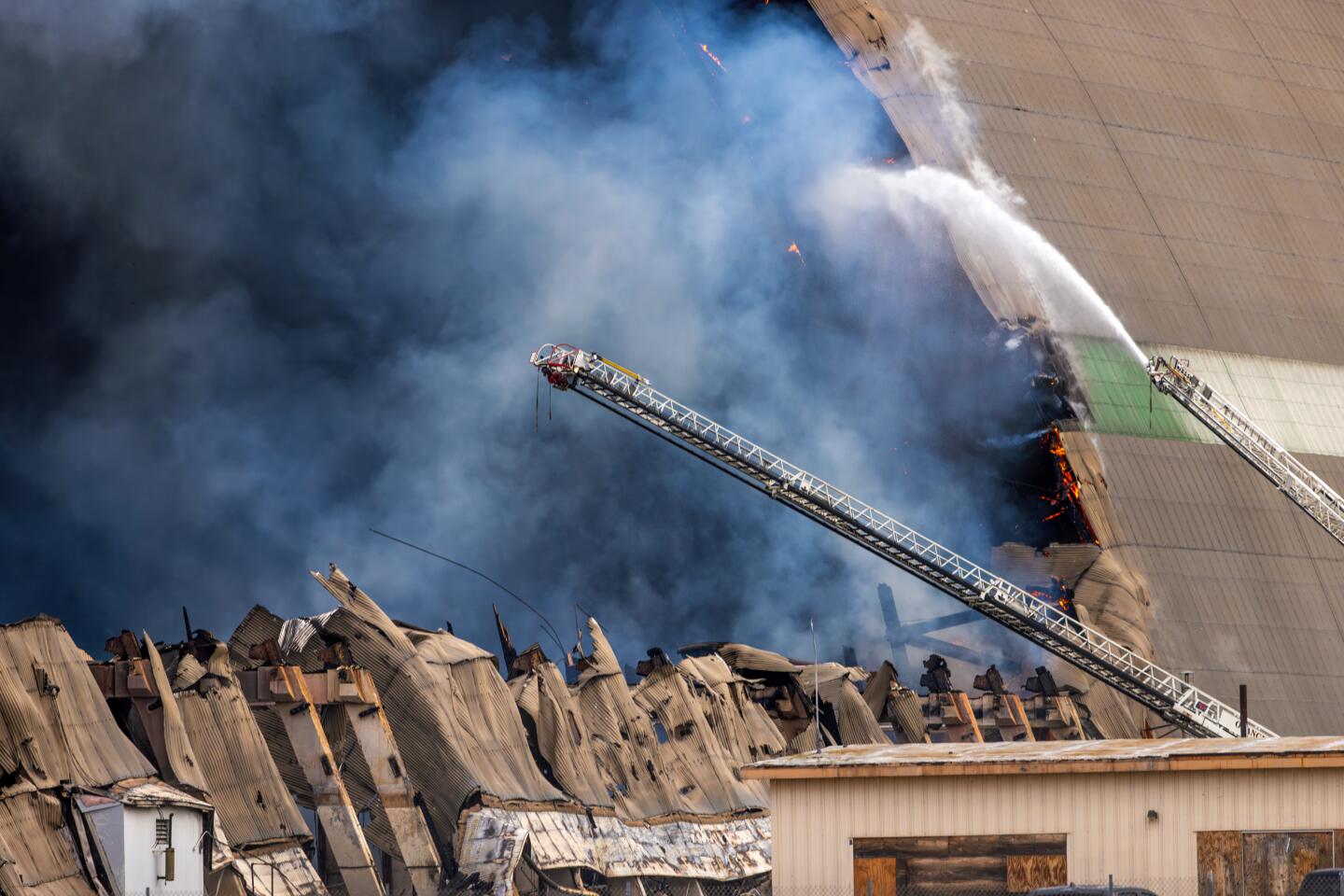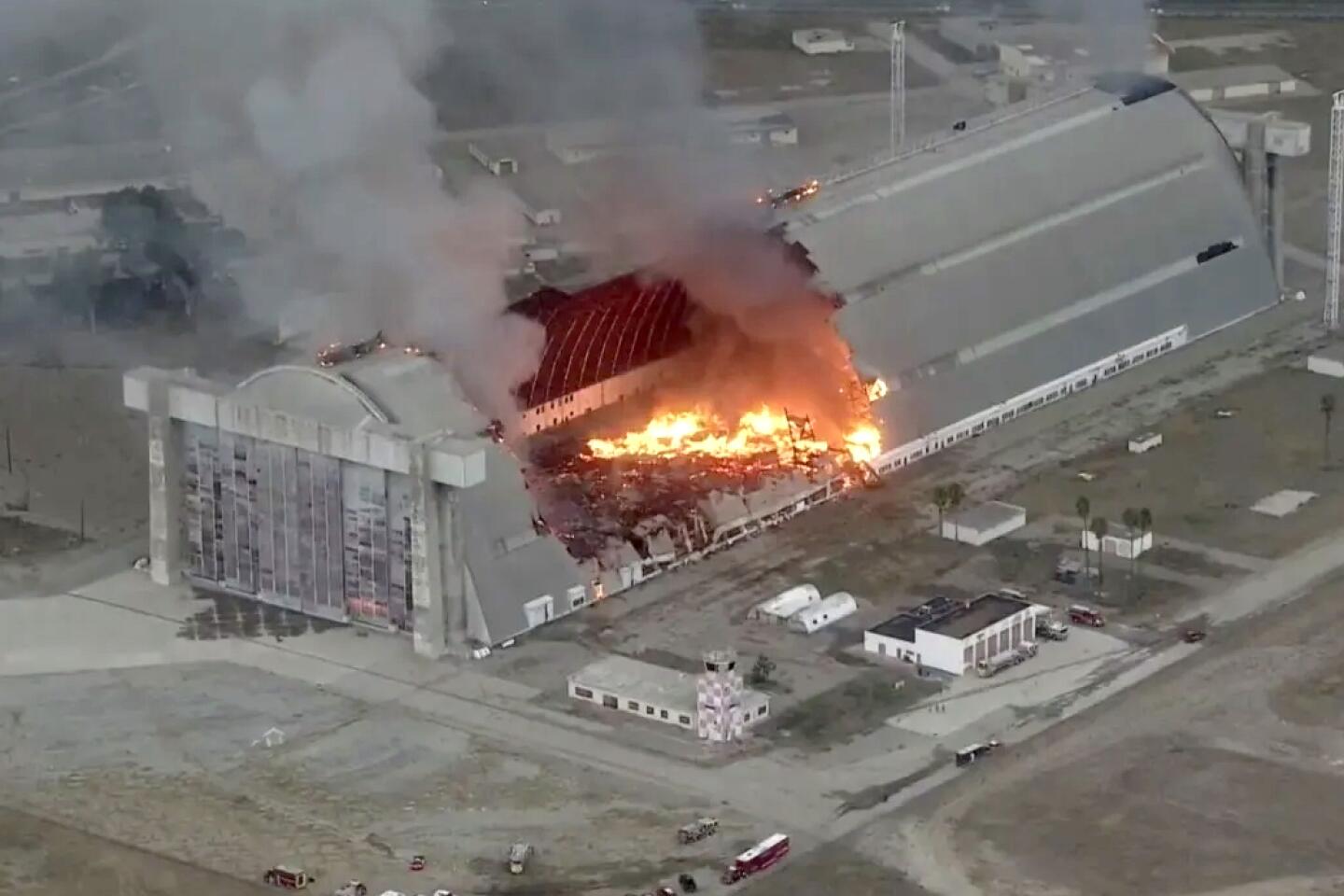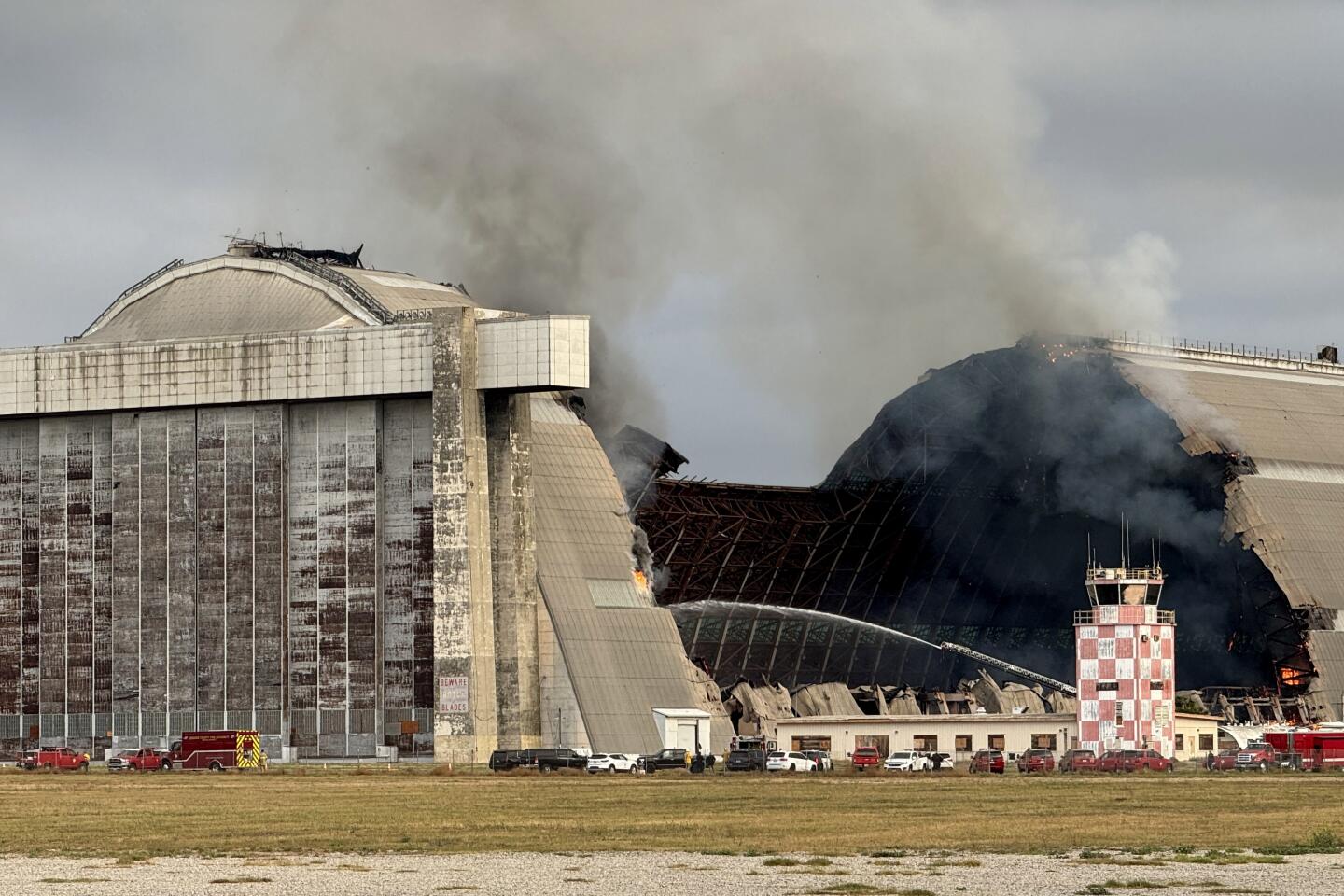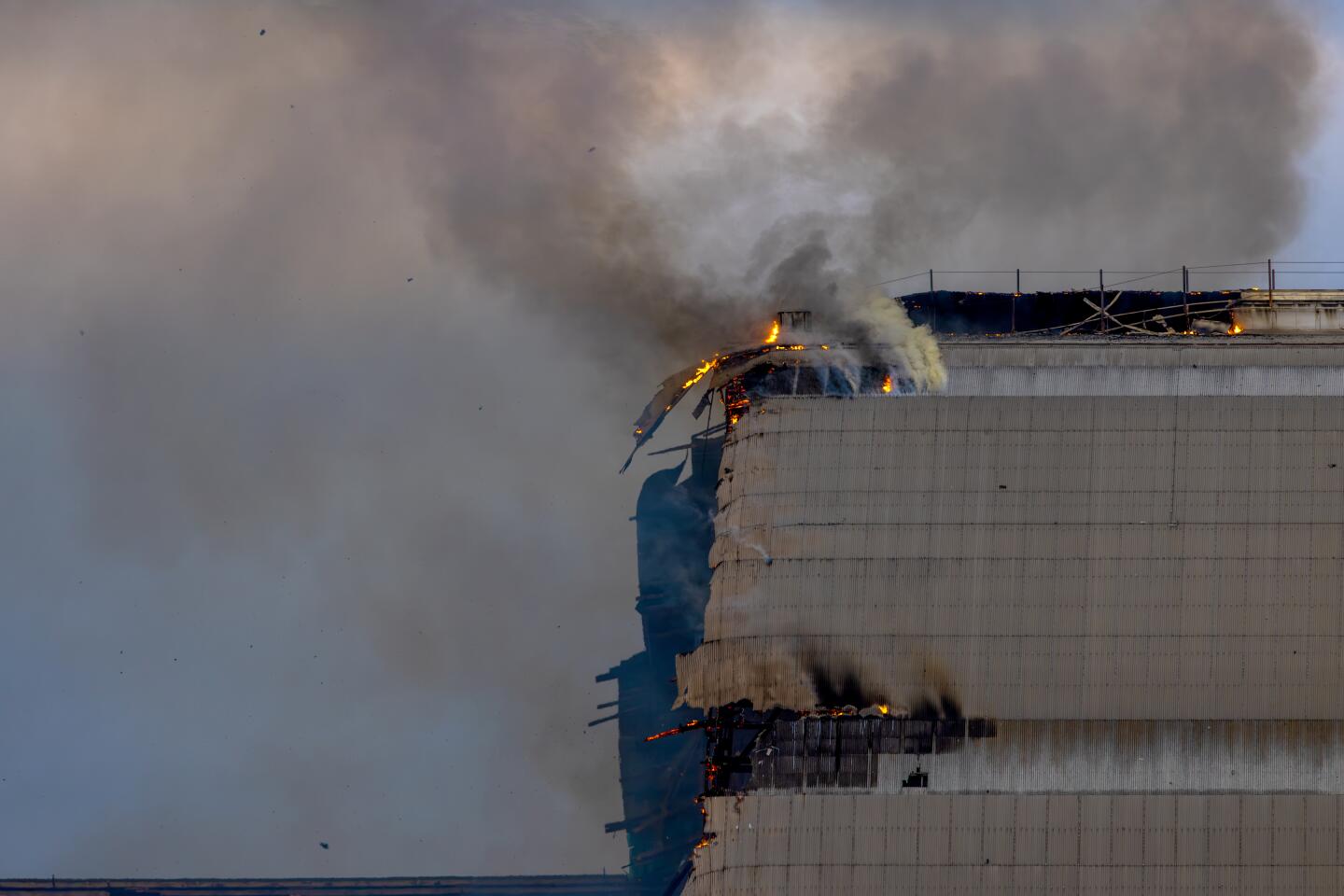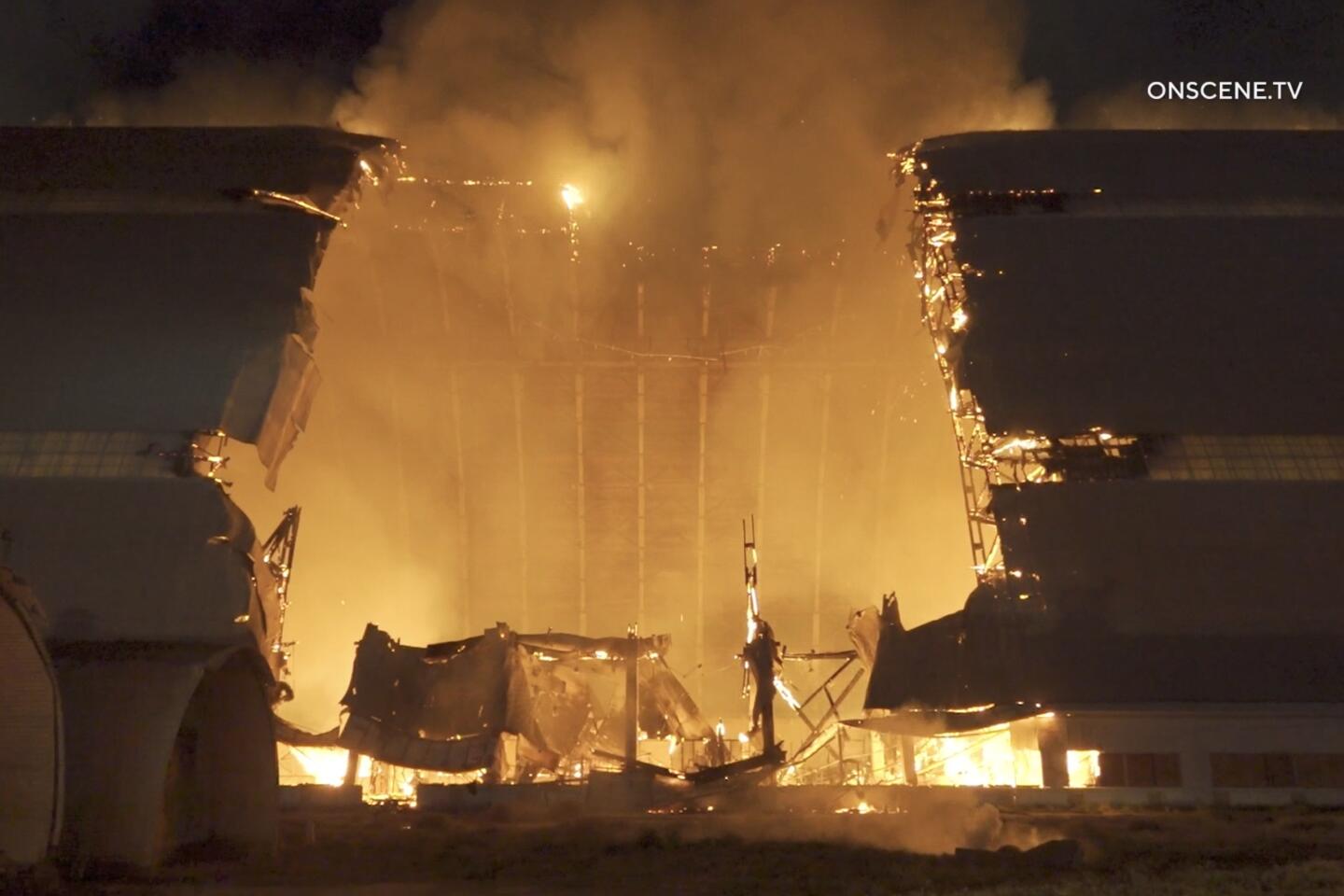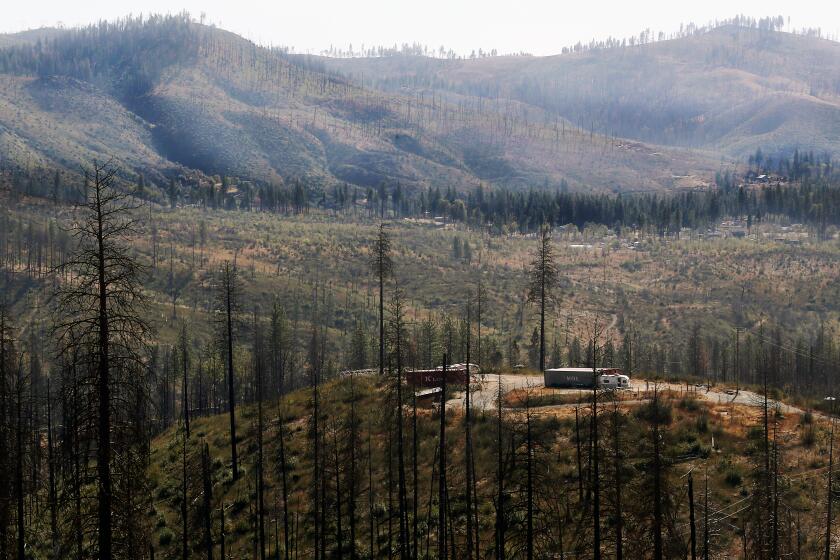Cavernous WWII-era hangar burns in Tustin, destroying a relic of Orange County’s military past
- Share via
For more than 80 years, two massive domed hangars loomed over Tustin’s southern edge, a relic of Orange County’s military history hemmed in by an expanding suburban landscape that replaced orange groves and lima bean fields with shopping centers and tract homes.
Reaching 17 stories high, more than 1,000 feet long and nearly 300 feet wide, the cavernous wooden structures at the now-defunct Marine Corps Air Station in Tustin once housed military helicopters and blimps armed with machine guns and bombs, so dwarfed by the buildings they looked like toys sitting inside.
The hangars took about six months to build on an accelerated schedule in 1942 as the U.S. ramped up its war effort after entering World War II. But on Tuesday, as smoke poured into the sky from a massive fire, the north hangar took just hours to burn before firefighters decided to let it go.
The Tustin blimp hangar lost to fire Tuesday was a Hollywood icon, starring in major productions including ‘Pearl Harbor,’ ‘Star Trek’ and ‘The Hindenburg.’
“History just went up in flames,” said John Gaita, 64, looking out on the smoldering hangar from a nearby shopping center.
The north hangar, near Valencia Avenue and Armstrong Road, caught fire just before 1 a.m. Flames chewed through the historic building throughout the day, collapsing section after section. What remains of the structure will eventually be demolished, fire officials said.
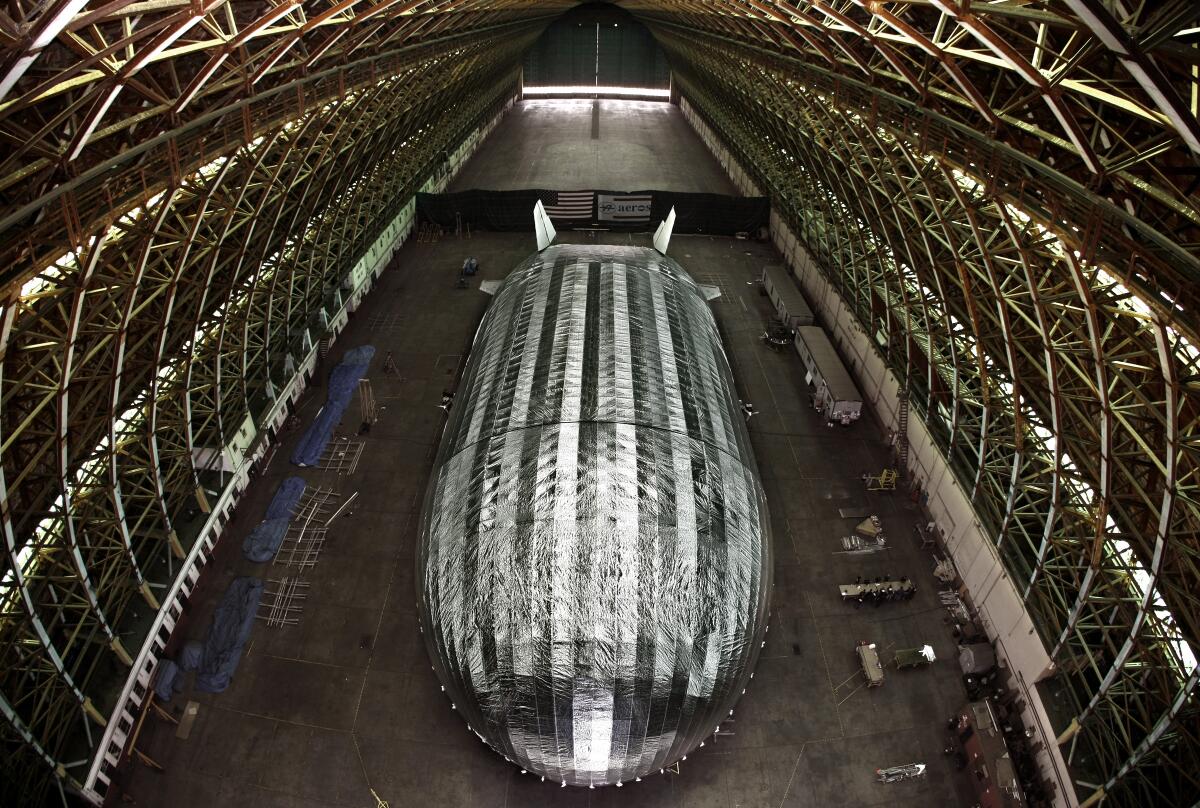
Thick smoke billowing from the hangar, which is owned by the U.S. Navy, was visible across the region. The sounds of the wood lattice that held up the roof collapsing echoed throughout the surrounding neighborhoods like tidal waves crashing along the shore.
Gaita, who was stationed at the former Tustin Air Base in the 1990s while he served in the Marine Corps as a helicopter pilot, drove from Laguna Niguel on Tuesday morning to see the hangar one last time.
The structures are so large that it would have been possible to play a basketball game, a football game and a soccer match in one building simultaneously. Their huge wooden doors, which have six leaves that weigh 26 tons to 39 tons each, fold open on steel rails like an accordion, powered by electric motors at each end. Giant concrete pylons anchor each corner.
In their heyday, the hangars attracted people from across the county. There were mud runs and even an annual car race. On weekends, civilians and clubs would visit the hangars to fly model airplanes inside the structures, which could hold their own weather at times, Gaita said.
In the mornings, the marine layer would enter as the hangar doors opened and gradually rose toward the ceiling. The moisture would fall to the ground as it condensed, making for a fun experiment for visitors to see how long they could keep their model airplanes airborne, Gaita said.
“The place was tremendous,” he said.
Jerry Boylan was convicted by a federal jury in connection with the 2019 fire that killed 34 people on the Conception dive boat.
Debbie Baker, 70, was awakened around 1:30 a.m. to helicopters flying above her home near the complex. She smelled the smoke and stepped outside to see massive flames overtaking one of the giant structures.
She mourned the hangar’s demise, fighting back tears as the structure burned. The buildings acted as a reminder of the county’s origins and its military history even after the base closed in 1999, she said.
“For years those hangars welcomed us home,” Baker said. “It’s what made this community special.”
Officials are investigating what caused the blaze.
The hangars were built mostly from Oregon Douglas fir, 2 million board-feet of wood that was treated with metallic salts as a fire retardant. But the size and construction of the structure made fighting the blaze a challenge.
One-fifth of all conifer forests in the Sierra are mismatched with the warmer climate and may not survive, according to Stanford University researchers.
Seventy OCFA firefighters on 11 engines and five fire trucks responded to the fire, which was so large and complex that officials deployed helicopters, including a Chinook used in wildfires, to drop water on the huge structure.
“That’s unheard of,” Orange County Fire Authority Chief Brian Fennessy said of deploying the aerial resources. “But we thought we would throw everything we could at it just in case we could stop it midway.”
But because of the “dynamic nature of the fire, and the imminent danger of collapse,” firefighters planned to allow the mostly wooden hangar to fall on its own before crews move in to extinguish the fire, Fennessy said.
Officials estimated the structure could burn for several hours, if not days.
The hangars are two of the world’s largest free-standing wooden structures. Both are listed in the Register of National Historic Places.
“This is not the end for what we call the north hangar that was envisioned,” Tustin Mayor Austin Lumbard said. “It’s not the dignified treatment that it deserves.”
After the base closed in 1999, the future of the beloved structures remained a long unanswered question as they continued to age and fall into disrepair.
The south hangar, which Tustin leased from the U.S. Navy, has been used for film productions, car commercials and other events. But the north hangar has become a continuing headache for officials who are in the midst of developing the land around the site into a mixed-use development known as Tustin Legacy.
The largely abandoned property has also attracted trespassers. In 2019, a teen had to be airlifted off the north hangar after she and two others climbed the structure late one night.
Drought has long been the norm for California. But the state had a historically wet winter, and El Niño is threatening again.
The north hangar’s roof partially collapsed during strong winds in 2013. The Navy spent about $3.2 million temporarily stabilizing the structure a year later, but the hangar remained closed. In 2021, long-awaited plans for the county to develop the site into a regional park fell through.
Last year, Tustin began a $330,000 cleanup effort of the base — the most significant since its closure — removing large containers, scrap piles, various abandoned equipment and interior broken fencing from the site, repairing fencing along the perimeter and trimming overgrown vegetation, which could make the site prone to fires.
Many residents had long hoped the slice of land could be turned into a park that would honor its military legacy. But now, the future of the site seems murkier than ever.
“It’s sad to see this go, because this is what the legacy was supposed to be all about,” Tustin resident Rob Jones, 69, said as he watched a portion of the building’s roof collapse. “We’ll watch it burn. It’ll be gone and it’ll never be back.”
Times staff photographer Irfan Khan and former staff writer Ben Brazil contributed to this report.
More to Read
Sign up for Essential California
The most important California stories and recommendations in your inbox every morning.
You may occasionally receive promotional content from the Los Angeles Times.
